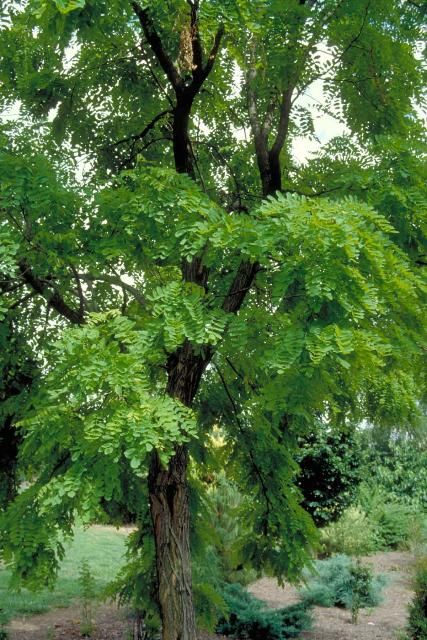Introduction
A fast-growing cultivar of the native deciduous locust, 'Frisia' black locust is probably capable of reaching 30 to 50 feet tall with a spread of 30 to 40 feet. The upright growth and short, irregular branches cast light shade below the tree, allowing a lawn to thrive. The 6- to 14-inch-long, dull, yellow leaves, made up of multiple leaflets, are some of the last to appear in spring and often drop early in the autumn, just barely fading to a sickly yellow/green before dropping. The yellow foliage lasts only for a short period in the spring in the south. For approximately a 10-day period in late spring, the trees are festooned with 4- to 8-inch-long, dense clusters of extremely fragrant, one-inch white blossoms (similar to sweet-peas) which are literally "alive" with the bustling activity of visiting bees. The honey which is produced is quite delicious and sought-after. The 2- to 4-inch-long, dark red to black, leathery seeds pods which follow will persist on the trees throughout the winter.

Credit: Ed Gilman, UF/IFAS
General Information
Scientific name: Robinia pseudoacacia
Pronunciation: roe-BIN-nee-uh soo-doe-uh-KAY-shuh
Common name(s): 'Frisia' black locust, 'Frisia' common locust
Family: Leguminosae
USDA hardiness zones: 4A through 8B (Fig. 2)
Origin: native to North America
Invasive potential: weedy native
Uses: reclamation; shade; specimen
Availability: somewhat available, may have to go out of the region to find the tree

Description
Height: 30 to 50 feet
Spread: 30 to 40 feet
Crown uniformity: irregular
Crown shape: oval, upright/erect
Crown density: open
Growth rate: fast
Texture: fine
Foliage
Leaf arrangement: alternate (Fig. 3)
Leaf type: odd-pinnately compound
Leaf margin: entire
Leaf shape: elliptic (oval), oblong, obovate
Leaf venation: pinnate
Leaf type and persistence: deciduous
Leaf blade length: less than 2 inches
Leaf color: yellow
Fall color: yellow
Fall characteristic: not showy

Flower
Flower color: white/cream/gray
Flower characteristics: showy
Fruit
Fruit shape: pod or pod-like
Fruit length: 1 to 3 inches, 3 to 6 inches
Fruit covering: dry or hard
Fruit color: black, red
Fruit characteristics: attracts birds; not showy; fruit/leaves a litter problem
Trunk and Branches
Trunk/bark/branches: branches don't droop; showy; typically one trunk; no thorns
Pruning requirement: needed for strong structure
Breakage: susceptible to breakage
Current year twig color: brown
Current year twig thickness: thin
Wood specific gravity: 0.69
Culture
Light requirement: full sun, partial sun, or partial shade
Soil tolerances: clay; sand; loam; acidic; alkaline; well-drained
Drought tolerance: high
Aerosol salt tolerance: high
Other
Roots: can form large surface roots
Winter interest: yes
Outstanding tree: no
Ozone sensitivity: unknown
Verticillium wilt susceptibility: susceptible
Pest resistance: sensitive to pests/diseases
Use and Management
These seeds are widely dispersed by birds and other wildlife, and along with the root suckering, invasive root system, black locust can spread into surrounding landscapes. This feature, along with the thorns found along the branches, should be considered when placing black locust in the ornamental garden. It is probably best saved for the reclamation project or roadside planting where trees receive no maintenance. If left to its own devices, black locust will form dense thickets, even on the poorest soils, a fact which makes it quite useful in reclamation applications, or along roadsides.
Although the wood of black locust is reputed to be extremely strong and durable (pioneers used it to fashion nails for building ships and houses), the branches are brittle and subject to damage in high winds. This may be due largely to the tendency for the branches to form a narrow angle with the trunk and to grow aggressively relative to the trunk forming embedded bark. This can be partially corrected by pruning the major branches so they grow to no more than about half the size of the trunk.
Able to tolerate drought, salt, and poor soil, black locust will grow in full sun or partial shade on almost any soil except that which is permanently wet. A tough tree which should be saved for the toughest sites. Not for general use in urban areas due to borer problems unless located on a moist, well-drained site with plenty of soil space.
Pests
Locust borer is a serious pest although borer-resistant clones are now being developed. Also bothered by carpenterworm, locust leaf miner, and scales. Leaf miner is a universal problem on the species. Trees along the highways in the south can be seen in summer riddled with damage from this pest.
Diseases
This tree is susceptible to canker, leaf spot, and powdery mildew.